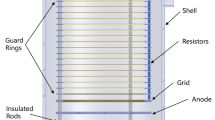Abstract
The silicon based pixel detector Timepix is a multi-parameter detector which gives simultaneously information about position, energy and arrival time of a particle hitting the detector. Applying the ΔE-E method with these detectors makes it possible to determine types of detected particles, separating them by charge. Using a thin silicon detector with thickness of 12 μm combined with a Timepix (300 μm), a ΔE-E telescope has been constructed. The telescope provides information about position, energy, time and type of registered particles. The emission probabilities and the energy distributions of ternary particles (He, Li, Be) from 252Cf spontaneous fission source were determined using this telescope. Besides the ternary particles, a few events were collected, which were attributed to the “pseudo” quaternary fission.
Similar content being viewed by others
References
Proceedings of the Seminar on Fission Pont d’Oye IV, Habay-la-Neuve, Belgium, October 5–8, 1999 (World Scientific Publ., 2000), p. 59.
S. Vermote, C. Wagemans, O. Serot, J. Heyse, J. van Gils, T. Soldner, P. Geltenbort, I. AlMahamid, G. Tian, and L. Rao, “Ternary particle emission in spontaneous fission of 250Cf and 252Cf and in neutron induced fission of 249Cf and 251Cf,” Nucl. Phys. A 837, 176 (2010).
Y. Ronen, “On the light particles in ternary fission,” Phys. Scr. 86, 065203–6 (2012).
V. G. Tishchenko, C. M. Herbach, D. Hilscher, and U. Jahnke, “Study of ternary and quaternary spontaneous fission of 252Cf with the NESSI detector,” Report HMI-B 588 (2002).
C. Wagemans, The Nuclear Fission Process (CRC, Boca Raton, FL, 1991).
Proceedings of the 2nd International Conference on Fission and Properties of Neutron-Rich Nuclei, St. Andrews, 1999 (World Scientific, 2000), p. 316.
Yu. N. Kopatch, “Quaternary fission of 252Cf,” GSI Scientific Report (GSI, Darmstadt, 2000), p. 28.
M. Mutterer and F. Gonnenwein, “Particular aspects of particle-accompanied fission,” Roman. Rep. Phys. 59, 533–544 (2007).
P. Jesinger, Yu. N. Kopatch, M. Mutterer, F. Gönnenwein, A. M. Gagarski, J. V. Kalben, V. Nesvizhevsky, G. A. Petrov, W. H. Trzaska, and H.-J. Wollersheim, “New experimental studies on the quaternary fission of 233, 235U(nth, f) and 252Cf (sf),” Eur. Phys. J. A 24, 379–388 (2005).
Neutron Spectroscopy, Nuclear Structure, Related Topics, Proceedings of the 21st International Seminar on Interaction of Neutrons with Nuclei, Alushta, May 20–25, 2013 (JINR, Dubna, 2014).
X. Llopart, R. Ballabriga, M. Campbell, L. Tlustos, and W. Wong, “Timepix, a 65k programmable pixel readout chip for arrival time, energy, and/or photon counting measurements,” Nucl. Instrum. Methods Phys. Res. A 581, 485–494 (2007).
C. Granja, J. Jakůbek, U. Koester, M. Platkevic, and S. Pospisil, “Response of the pixel detector TimePix to heavy ions,” Nucl. Instrum. Methods Phys. Res. A 633, S198–S202 (2011).
V. Kraus, M. Holik, J. Jakubek, M. Kroupa, P. Soukup, and Z. Vykydal, “FITPix-fast interface for TimePix pixel detectors,” J. Instrum. 6, C01079 (2011).
D. Turecek, T. Holy, J. Jakubek, S. Pospisil, and Z. Vykydal, “Pixelman: a multi-platform data acquisition and processing software package for Medipix2, Timepix and Medipix3 detectors,” J. Instrum. 6, C01046 (2011).
Proceedings of the 3rd IAEA Symposium on Nuclear Physics and Chemistry of Fission, Rochester, 1973 (IAEA, Vienna, 1973), Vol. 2, p. 389.
S. W. Cosper, J. Cerny, and R. C. Gatti, “Long-range particles of Z = 1 to 4 emitted during the spontaneous fission of 252Cf,” Phys. Rev. 154, 1193 (1967).
W. Loveland, “Alpha-particle energy spectrum associated with spontaneous fission,” Phys. Rev. C 9, 395 (1974).
Author information
Authors and Affiliations
Corresponding author
Additional information
The article is published in the original.
Rights and permissions
About this article
Cite this article
Ahmadov, G.S., Kopatch, Y.N., Telezhnikov, S.A. et al. Detection of ternary and quaternary fission fragments from 252Cf with a position-sensitive ΔE-E telescope based on silicon detectors. Phys. Part. Nuclei Lett. 12, 542–549 (2015). https://doi.org/10.1134/S1547477115040032
Published:
Issue Date:
DOI: https://doi.org/10.1134/S1547477115040032




